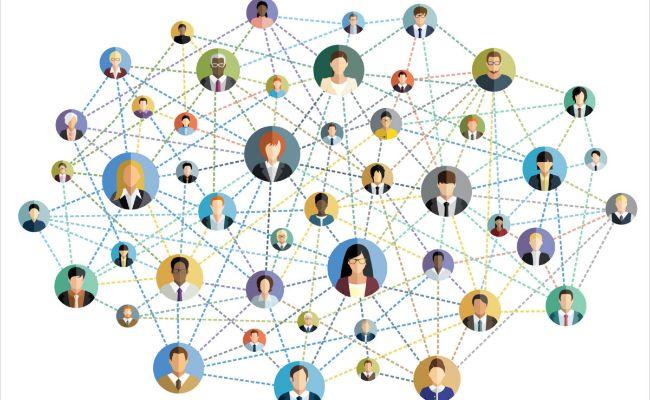From the smoke signal to email, advances in communication have had organizational consequences. In this series, we’ll look at how online social networks are beginning to change the way business is done: first, at what coaches and academics have learned about what electronic networks are and aren’t good for and a Q&A with Julia Hobsbawm, author of Fully Connected; second, at what the latest research says about how to make your personal network work; third, at some of the innovative ways in which Chinese businesses have learned to use social networks; and finally, at how the social network may evolve from here.
Part 1: Social capital in a virtual age
Business networking used to be a fairly grim affair. You’d stand around in a convention hall, shaking hands and trading business cards, and very occasionally, make a connection that had some value. Almost without exception, these people mattered much less than the people you’d worked with, your long time customers, or old school chums. For everybody but the most determined extrovert, it was a dreaded event.
That nightmare of bad coffee and small talk is still alive and well, but over the last 15 years, a new element has been added to the mix: the online professional network. Although online networking has its grim and desperate side too, its rapid growth suggests that people are finding it useful. Founded in 2002, LinkedIn now has over 500 million members in 200 countries, nearly all of them just a virtual handshake away from an introduction.
Just as social networks and dating services have led to changes in the way people relate to each other in their free time, LinkedIn and other online professional networks and internal messaging software such as Yammer are beginning to change the way people make deals, find jobs, and get their jobs done.
At the macro-level, social networks seem to be good for generating social capital, and economists tend to find that social capital correlates well with economic growth. One 2015 study found that in the US between 2010 and 2014, job growth in the top quintile of metro areas outperformed job growth in the bottom quintile, 8.2% over the four years compared to 3.5%. Regions with high numbers of contacts per capita were also more resilient to economic shocks during the Great Recession.
Dr. Michael Mandel, the leader of the study and Chief Economic Strategist of the Progressive Policy Institute, cautioned in his report that this should be considered correlation rather than causation. However, the effect is so pronounced that in 2015, the McKinsey Global Institute predicted that online professional networks could add an additional $2.7 trillion to global GDP by 2025.
Yin’s colleague, Milan Miric, an assistant professor of Data Sciences and Operations at Marshall, agrees. “I would guess that it increases their choice set in hiring, but I am not sure about the magnitude of the effect.”
Miric believes social media may also be giving startups a new channel to share information with the world. “With the growth of social media (whether they be more informal like Facebook and Twitter or more formal like LinkedIn), my sense is that these firms have a public outlet through which they can selectively reveal information about themselves and make it accessible to all potential investors, competitors and regulators,” he says.
Some observers believe that startups and other businesses focused on innovation may be finding these networks particularly valuable.
“One key innovation principle is that magic happens at intersections, when different skills and mindsets collide,” says Scott Anthony, Managing Partner of the Singapore office of Innosight, a global innovation advisory firm. “Social networks make it easy for companies to get to those intersections, to find and learn from people who have additive experience. This is both in broad networks like LinkedIn and expert networks like the Gerson Lehmann Group.”
In hiring, for instance, social networks have made an important difference to early-stage companies, according to Anthony. “For startups, companies now have the equivalent of a Korn Ferry like headhunter at their fingertips! It is a game changer in terms of the quest for talent.”
Two professors at the University of Southern California’s Marshall School of Business share his view. “I speculate that these networks change the early hiring choice set for early stage firms (they can observe and contact potential hires they would not previously have been able to access through their smaller social network),” says Prof. Pai-Ling Yin, an Associate Professor of Clinical Entrepreneurship and Director of the Technology Commercialization Initiative.
But human capacities may limit the potential of these networks. Scholars have estimated that 90% of communication is nonverbal, which means that online textual communication tends to have limited value in creating a social connection.
“Online works OK, but it is not as effective as face-to-face,” writes Robin Dunbar, a professor of evolutionary psychology at Oxford University, in an e-mail. “A video channel (e.g. Skype) works better than a text-based channel. But in the end, it seems that nothing is as effective as face-to-face because you can do things (including physical contact, eating, drinking etc) that play an important role in social bonding that you simply cannot do online.”
Other communication experts are even more skeptical about online connections. “You lose all context…it’s a paltrier way of living or working,” says Laurence Prusak, a Boston-based researcher and consultant who specializes in knowledge management.
Several studies have suggested that our reliance on texting and online social networks may already be affecting how we interact. For example, one 2015 study by Microsoft Canada found that the average human attention span has shrunk from 12 seconds in 2000 to 8 seconds today – one second less than that of a goldfish. Researchers found that when it came to allocating attention, connecting with content on an emotional level, and processing information, moderate social media users performed better than average, while high social media users performed worse.
But Mariano Tufró, founder and director of Leadership Minds, a London leadership training consultancy, believes online networks have a useful role.
In his own firm’s business development, Tufró says, he’s found LinkedIn to be most useful as a way to encourage face-to-face meetings. “What I’ve noticed is that I can stay in touch with way more people than I did before,” he says.
Shawn Callahan, founder of Anecdote, a Melbourne-based corporate storytelling consultancy, also doesn’t believe that social media isn’t shrinking our attention span when it comes to stories.
“The vast majority of corporate stories are told orally so I would say social media hasn’t really changed that. If anything social media has amplified oral storytelling because each tweet, yammer post or Instagram picture is a trigger for a story to be told face to face among colleagues in the workplace,” he writes, in an email.
Even if we can listen, however, other cognitive limits may still limit the value of social networks. In the 1990s, Oxford’s Dunbar theorized that the number of people with whom one can maintain stable social relationships is limited to around 150. In some recent research using Facebook data, he found that Dunbar’s Number still seems to hold true.
On the other hand, artificial intelligence isn’t as limited as our own. Researchers have developed tools that allow them to monitor the overall mood of an organization, making it theoretically possible to find emerging sources of trouble early and correct them. New tools such as SenseMaker, a qualitative survey system produced by Cognitive Edge, make it possible to extract insights from qualitative interviews on a massive scale, according to Tufró. “SenseMaker lets you listen to everybody and analyze that data and zoom into it as needed,” he explains.
The insights generated by such systems may have important implications for organizational performance. For example, one 2015 study that analyzed the online chats of day traders over a two-year period found that the traders who used more emotional language tended to be less successful than their more detached colleagues.
Another study, conducted in 2016, found that the shape of networks actually changes under stress. The study’s analysis of instant messages by traders at a hedge fund found that in the face of a price shock, the network tended to “turtle up,” that is, traders would turn to their most familiar contacts for information, exactly the opposite tactic sociological theory suggests they should take. Sociologists have found that if they need to adapt successfully to an environmental change, people tend to be better off reaching out to weaker ties. Such distant connections tend to have more unfamiliar and possibly useful information, for the same reason that an acquaintance is more likely to have heard of a job opening you haven’t heard about than your best friend.




















